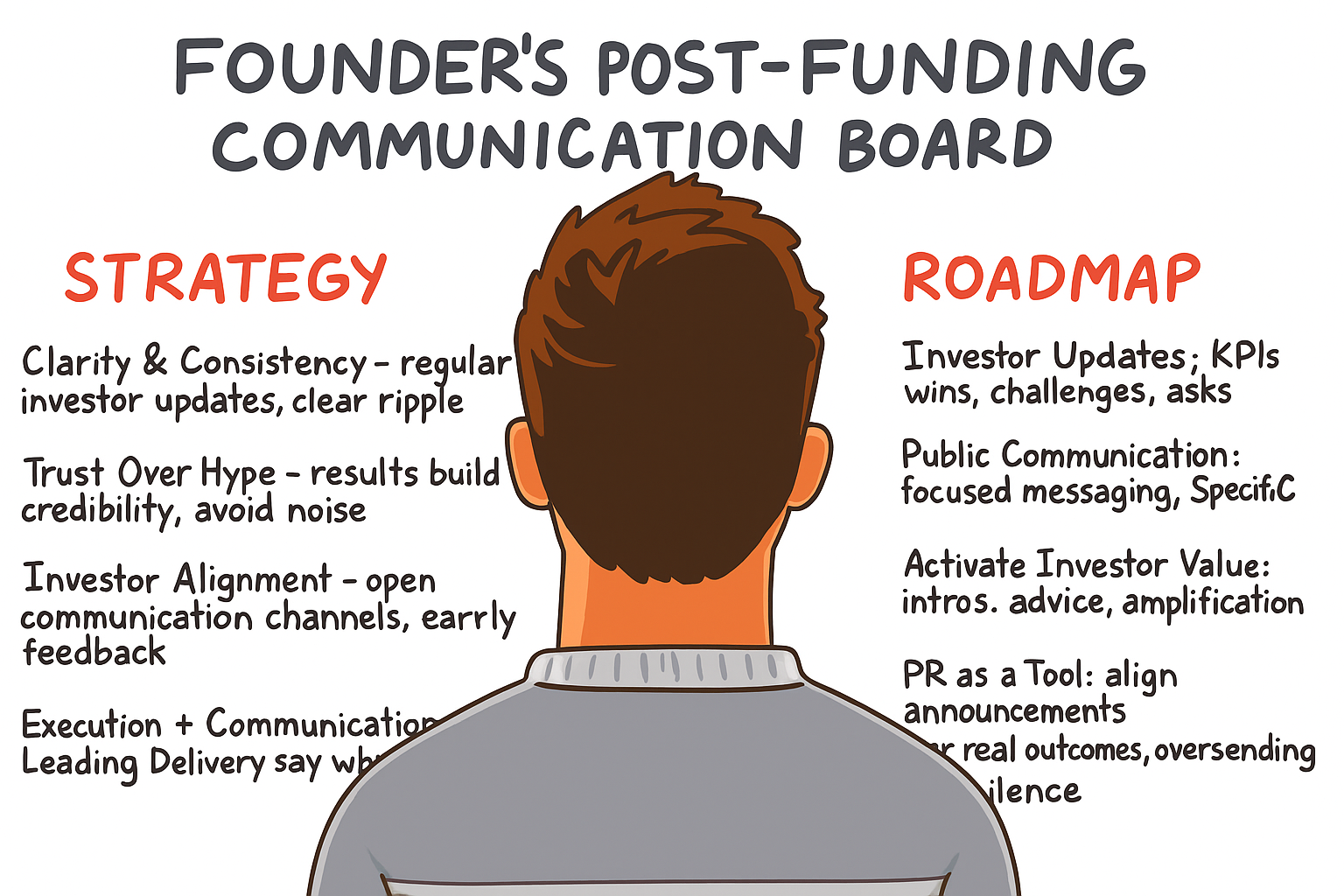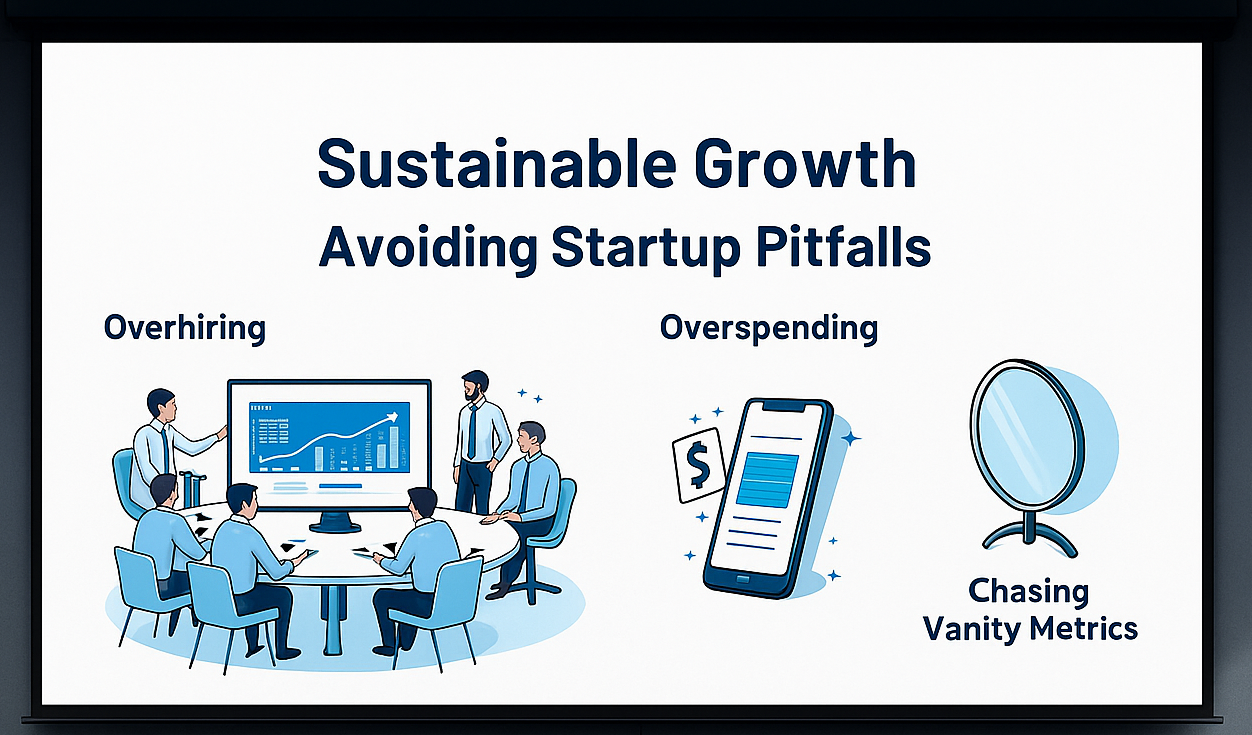Post-Funding Communication: A Founders' Realistic Playbook

You did it.
After endless pitch meetings, after-hours deck edits, and endless uncertainty, you secured your first sizable round of funding. That’s a huge win. The papers are signed, the funds are wired, and congratulations are flooding in from friends, mentors, and supporters. And the pressure? It’s bigger than ever.
Raising money, by itself, doesn’t prove your business model. What it does is grant you the opportunity to test it at scale, to show you can spend wisely, deliver fast without sacrificing quality, and make real progress toward your next milestone: sustained profitability, a successful Series A, or whatever your next goal is.
And here’s the thing: execution is one part of your job. How you communicate that execution becomes just as important. Investors, team members, future hires, competitors; they’re all watching. They want to see not just that you said you’d do things, but that you are doing them.
Below is a practical guide to communicating post-funding and how to do it in a way that builds trust, unlocks resources, and keeps you focused on what matters.
Separate investor relations vs. public communication

When your funding closes, don’t fall into the trap of thinking communication is just one channel. In reality, you will be managing at least two distinct communication tracks, each one with its own purpose and audience.
Investor Communication = Data, strategy, and clarity
Your investors are not going to read your press releases or social media for updates. They might follow your PR efforts, but that’s not where they look for meaningful information. What they want is clear, consistent data showing how the business is performing and how their capital is being deployed.
Here’s what strong investor communication should deliver:
- How you're deploying capital
- What’s working and what isn’t
- Milestones hit or missed
- The support you need to move faster
Maintain a regular pace: monthly or quarterly updates work well. The exact frequency matters less than your consistency and the quality of your content.
Each update should include:
- Key metrics: MRR, burn rate, CAC vs. LTV, runway, churn
- Product or GTM milestones
- Key hires or departures
- Risks, blockers, and mitigation strategies
- Clear asks: intros, advice, partnerships, etc.
For a structured template, the Monthly Investor Update Template by Antler offers a strong reference.
Public Communication = Narrative, momentum, and visibility
The other side of the coin is public communication, operating by different rules. Here, you're aiming to build narrative and momentum. Use the funding milestone to remind your audience of:
.png)
- The problem you’re solving and why it matters now
- The progress you’ve made and where you’re going next
- How will this funding help you deliver results faster or at a bigger scale?
- A clear call-to-action (e.g., hiring, product launch, beta testers)
This is also an opportunity to reintroduce your brand to the market. But be cautious: resist the urge to overhype and keep your messaging grounded in:
- A clear, proud funding announcement
- Simple, jargon-free language
- Proof points: early traction, validation, or customer success
While your investor and public communication should align in intent, they must differ in tone and content. Think of them as two complementary lenses, one internal and strategic, the other external and inspiring.
2. Understand what your investors want

Once the funds are in your account, expectations change. Investors stop looking at you through the lens of potential. From now on, they measure you by execution, maturity and how you’re allocating capital (does each dollar move you measurably closer to the next milestone?)
What does that mean in practice?
- Execution rhythm: Are you shipping features, closing customers, and learning fast from what works and what doesn’t? Momentum matters more than perfection.
- Strategic thinking: Do you know what the next round looks like? Are you tying this raise directly to milestones that lead to a Series A or a path to profitability? Investors want to see that you’re already thinking one or two steps ahead.
- Maturity: Are you identifying issues early and being transparent about them? Smart investors would rather hear about problems when they’re still small and solvable than discover them too late.
They don’t expect perfection as they are aware of the chaos. But they do expect: Transparency: Hiding problems breaks trust; Metrics that matter: MRR, burn rate, CAC/LTV, retention, not vanity stats; Forward thinking: Clear picture of how this round moves you closer to the next milestone.
Here is an example of an update that builds trust:
“We shipped our mobile app beta to 200 testers. Early feedback is positive on usability, but performance issues surfaced on Android devices. We’re prioritizing fixes now and expect to re-release within two weeks. The delay means our public launch shifts to October.”
This kind of honest, insight-led communication builds confidence far more than bragging about growth with no context.
3. Use communication to unlock more than capital

Capital is the most visible contribution investors make, but it’s far from the only one. For many founders, the real benefit comes from the doors investors open and the guidance they offer after their investment. And communication unlocks that value. Updates aren’t just reporting, but an invitation for investors to step in where they can really make a difference.
Use your updates to ask investors for support:
- Ask for help: Be clear about the support you need. Do you need help with hiring a VP of Sales? Making introductions to enterprise customers? Preparing for the next round? Investors cannot read your mind. A brief statement of what you need in each update makes it very easy for them to act.
- Share trade-offs: If you’re deciding between two markets, delaying a feature, or changing pricing, keep them in the loop. Sharing your thought process does not make you look less certain; it shows clarity of thinking and builds trust by allowing investors to understand how you think.
- Inform early: Don’t wait until you’re raising again or facing a crisis to involve your investors. Keeping them informed and engaged before big moves (e.g. international expansion, new product lines) allows them to provide input, point out risks, and support your strategy.
What happens when you engage proactively?
When you treat communication as a two-way channel, investors are far more likely to:
- Open up their networks: Warm intros to candidates, customers, or new investors
- Help with tough calls: Pricing, GTM strategy, fundraising preparations
- Amplify your story: Mentioning you in their media, events, or other portfolio showcases
But they can only do this if they know what you’re working on and what you need. As a founder, treat investors as growth partners and not just check-writers.
4. Use PR to serve real goals
Post-funding PR should support your business, and not your ego. Flashy headlines, viral LinkedIn posts, and media buzz make us all excited. But if your PR isn’t tied to clear outcomes, it is just a waste of time, money, and trust.

How to get post-funding PR right
- Keep messaging focused and simple
Make sure that people walk away knowing three things: what you do, why now, and what this funding enables. Skip the jargon. Tell a story that’s ambitious yet grounded. - Be specific about impact
Don’t just say “this funding will help us grow.” Instead, connect the announcement to real goals: “This round helps us launch into two new markets by Q1.” - Always include a call-to-action
Turn attention into action: “We’re hiring across engineering, sales, and marketing. Join us”; “Sign up to test our beta here”; “Looking for partners in logistics and retail. Reach out.” - Choose your channels wisely
You don’t always need TechCrunch. Sometimes, a well-written blog post amplified on LinkedIn reaches your targeted audience. In other cases, niche trade publications may offer better ROI than general tech media.
Visibility only matters if it supports execution. Otherwise, it's just noise. Remember, PRis not a trophy; it’s a tool. Use it strategically to fuel your growth, not just to announce it.
5. Common post-funding mistakes to avoid
Many startups stumble right after raising their first sizable round. Big capital builds confidence, but it also creates blind spots. The fastest way to lose credibility is to treat fundraising as success instead of seeing it as an enabler.

Watch out for the following traps:
- Overhiring too quickly: Headcount isn’t the same as growth. Scaling your team faster than you realistically need, faster than your systems, culture, or strategy can handle, leads to overspend. Always hire with purpose.
- Overspending on PR instead of customer acquisition: Big announcements will grab attention, but they rarely drive revenue. If your PR budget outpaces your investment in customer acquisition, your growth engine will stall.
- Chasing vanity metrics: Signups, followers, and press don’t matter if you can’t retain users or convert them into paying customers. Focus on CAC, LTV, and burn efficiency, as these are the metrics that investors care about.
- Going silent when things get hard: Investors don’t expect perfection, but they do expect honesty. Disappearing in tough times damages trust. Honest updates, especially when challenges arise, show maturity and build stronger investor relationships.
Final thoughts
Raising your first round isn't the end of the journey but rather a first step towards next rounds and growth. It marks the start of a tougher, higher-stakes phase where execution and communication must work hand in hand.
Your investors, your future hires, your early customers, they’re all paying attention to the signals you send. Those signals tell them whether you’re a founder who can scale responsibly, or one who will burn through momentum just as quickly as money.
So: Keep your investor updates sharp, honest, and consistent; Use public communication to build credibility, not hype; Be transparent about your challenges and clear about your tasks; Remember that real leadership is built on execution, not just excitement.
Investors are not only betting on your product; they are betting on your ability to build trust, align stakeholders’ interests, and consistently show progress. Post-funding communication isn’t about hype. It’s about proving, day by day, that you can turn capital into growth, credibility, and long-term success.
More from Our Blog
Welcome to the EGC Blog, where we delve into the world of entrepreneurship and innovation. Here, you'll find inspiring stories, practical tips, and insightful discussions aimed at empowering the next generation of global changemakers.
Subscribe to our Newsletter on LinkedIn and Never Miss an Update


.png)
.png)